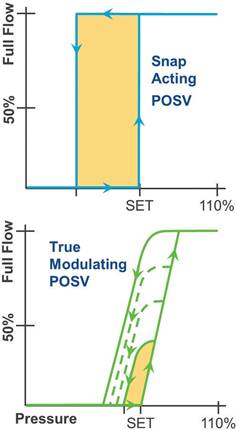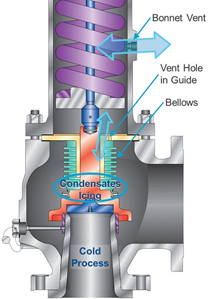Enhanced Safety in LNG Applications
For more than 40 years, the safety record of the global LNG industry has been excellent, due to attention to detail in engineering, construction and operations.
#components #knowyourvalves
For more than 40 years, the safety record of the global LNG industry has been excellent, due to attention to detail in engineering, construction, and operations. While the safety of processing and handling LNG has always been paramount, it is now even more important to retain this excellent record as LNG installations are getting smaller, therefore multiplying and being constructed closer to populous areas. The reliability and dependability of pressure safety valves (PSVs) protecting these installations is more critical than ever
PRESSURE SAFETY VALVES
To avoid this danger, balanced bellows safety valves are commonly used across all industries. A metallic bellows is mounted on top of the disc of the valve to protect it from the header backpressure, so the safety valve opens at the correct pressure, whatever the variations of the header pressure.
For this to work properly, the volume inside the bellows, connected to the bonnet of the valve, must be freely vented to the atmosphere, which is accomplished via a vent in the bonnet. As a result, only atmospheric pressure acts on the bellows, on top of the disc and around the spindle and guide. As these parts cool down with the process temperature—which can be as low as -260ºF (-162ºC) on LNG processes—the air moisture will condense and freeze at the lowest point: inside the bellows on top of the disc (Figure 1). This is dangerous—and invisible. As the ice builds up slowly, the disc will be blocked from opening, without this being visible from the outside, thus, the equipment is no longer protected.
Many standards refer to this situation. For example, API Standard 520 part 1, clause 4.2.1.3.9 reads: “[…] the bonnet of a balanced PRV shall be vented to atmosphere at all times. The user should be cautioned of the potential for freezing of atmospheric moisture inside the bonnet.”
CRYOGENIC PILOT-OPERATED SAFETY VALVES
This is why, since the late 1960s, pilot-operated safety valves (POSV) have been used extensively on LNG installations onshore as well as on LNG tanker ships.
POSVs use the system pressure as a closing force so that the seat tight- ness is at its maximum close to the set pressure—completely opposite from a spring-loaded valve. With the addition of a properly engineered soft seat, the tightness on cold or cryogenic service will be reinforced to avoid any leakage or even icing risk, while reducing maintenance costs.
Instead of a disk, a piston closes on the nozzle. This piston makes the POSV inherently balanced against backpressure, by design, without any additional accessory.
There are several factors to consider when installing a POSV on a cold or cryogenic application. The valve and its pilot must be specifically designed to perform in these demanding cryogenic applications: Use of a standard design with all parts in austenitic stainless steel is obviously not sufficient.
Particularly, the pilot must be relatively isolated from the cryogenic temperatures. There are many proven ways of achieving this. One way, which must not be overlooked on site, is that while the main valve can usually be insulated like its associated piping, the pilot and tubing must be kept out of the insulation, in the open air.
The pilot should be non-flowing to limit the input of cryogenic media through it. A non-flowing pilot will still flow a little but only to reclose the valve: It does not flow while the main valve is opened and flowing. To reclose the main valve, the non-flowing pilot will then send process fluid into the dome of the main valve—the volume on top of the main valve piston. By re-pressurizing the dome, the piston moves down and re-closes the valve. So, the non-flowing pilot will flow only the dome volume at each open-close cycle. But a flowing pilot will flow as long as the main valve itself is opened. With such a large amount of cryogenic fluid passing through, the pilot may freeze and lock open and not be able to reclose the main valve after an event.
Until 20 years ago, the only suitable pilot technology for these applications was the snap-acting pilot, which has only two discrete positions: fully closed or fully opened. In a similar way to spring-loaded safety valves, the POSV with a snap-acting pilot will discharge its full capacity every time it opens, whatever the real needs of the protected system, leading to unnecessary heavy losses of products to flaring.
Furthermore, the snap-acting pilot itself cannot be balanced against backpressure, so any release of natural gas from the pilot must be to the atmosphere, which is dangerous and harmful.
This changed 20 years ago, when the first LNG site started operations with modulating pilot-operated safety valves.
TRUE MODULATING POSVS
Being truly modulating they also control the valve opening exactly in proportion to the needs of the system: important reduction of emissions as the valve will release only the strict amount of gas necessary to keep the pressure within safe limits. At the same time, this obviously eliminates the risk of oversizing and the dangerous PSV instability it can bring (Figure 2).
These pilots will also be non-flowing to reduce the amount of cryogenic fluid passing through. As the opening of the main valve is always proportional to the needs of the protected system, they typically will never need to open fully, reducing even further the volume of process fluid needed to reclose the valve at each cycle.
On liquefied gas processes, most safety valves applications will develop a mixed-phase flow as the liquefied gas flashes into vapor across the nozzle of the valve. Mixed-phase applications like these are very demanding on PSVs, causing a high amount of backpressure, additional instability on the valve and difficult reclosing. True modulating pilots have shown to be a reliable, safety valve technology for mixed-phase flows, keeping the main valve stable, even with this high level of backpressure and whatever the flashing mix; they are able to reclose the valve within the usual limits as such pilots react only on static pressure.
True modulating pilot-operated safety valves, with dedicated design and configuration for cryogenic services, offer numerous advantages for efficient and reliable pressure protection of LNG installations.
While conventional spring-loaded safety valves can provide an acceptable level of protection—particularly when fitted with a soft seat of proven design—the balanced bellows spring-loaded valves represent the potential for highly hazardous situations and should be avoided on cold or cryogenic services.
Pressure safety valves act as safeguards to protect the integrity of expensive equipment, and doing so, the lives of people and the environment. Because LNG installations are safely designed and operated, most will probably never experience the opening of a safety valve. However, it is important the design and configuration of such safety valves is correctly adapted to the process conditions.
As the supply of LNG to retail market grows, it is imperative the level of care and custody that the historical LNG industry has provided be maintained by all retail LNG market participants. Industry knowledge, and the collective lessons learned of the broader LNG industry, need to be shared with new entries.
1US Department of Energy, Liquefied Natural Gas: Understanding the Basic Facts, Aug 2005
2American Petroleum Institute, API 520: Sizing, Selection, and Installation of Pressure-relieving Devices - Part 1: Sizing and Selection, 10th edition, October 2020
3GIIGNL, Retail LNG Handbook, 1st edition, 2015
Jean-Paul Boyer is process director PRV, Europe, for Emerson Automation Solutions. Boyer is a former merchant marine engineer officer and has worked with safety valves for more than 30 years. His main areas of expertise are the use of safety valves for cryogenic services and mixed phase flows.
RELATED CONTENT
-
Beauty or a Beast? Using NDE on Valve Components
When it comes to valves, “beauty is only skin-deep” is often a true statement. Since Superman and his X-ray eyes don’t really exist, there is no way to verify the quality of a valve or valve component just by looking at it.
-
Gaskets Are Not Created Equal
Gaskets are near the bottom of the food chain of valve components; trim, body materials and packing seem to get a lot more press.
-
The Critical Stem Nut: Who is Responsible for Maintenance?
One of the most important components of an automated threaded stem valve is the ubiquitous stem nut, a relatively simple and unsophisticated mechanical device that converts the rotary motion of an actuator into the linear stem movement needed to open or close one of the many types of gate valves or sluice gates.













 Unloading large gate valve.jpg;maxWidth=214)